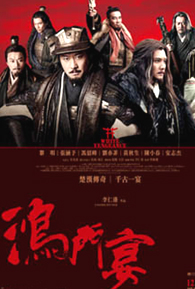
The four great Chinese novels are The Romance of the Three Kingdoms, Journey to the West, Outlaws of the Marsh and The Dream of the Red Mansion. In recent years, ROTK has become the subject of many war epics (both feature films and television series) made in the People's Republic of China (PRC), thanks to a censorship policy that indirectly encourages its local filmmakers to stick to historical subjects and glitzy, big budget productions.
White Vengeance is Hong Kong director Daniel Lee's foray into this mode of PRC filmmaking, and Lee brings with him his typical Hong Kong ambition. Firstly, White Vengeance is not about ROTK. Rather, it's set in another period of warlordism in China, 400 years before the events of ROTK. To be honest, it's not a particularly brilliant or savage period; that's why ROTK is one of the three great novels of China, and is based on a centuries-old folk tradition of oral storytelling and opera that is in turn based on the historiography of the Jin Dynasty. For this reason also, the Chinese byword for a Machiavellian politician is Cao Cao and not Liu Bang.
Daniel Lee's conceit for White Vengeance is to present the pre-Han warlord era, its warlords, strategists, generals, and their plots and counter-plots as an equal to those in ROTK's pre-Jin warlord era. It's a conceit that holds great potential for a historical revisionist look at a famous historical period in Chinese history. While John Woo focused on the Battle of the Red Cliff as the confluence between the three warlord factions and the turning point in the warlord era leading to the Jin Dynasty, Lee chooses the Feast of the Hong Gate as the turning point in the warlord era leading to the Han Dynasty.
Given that conventional historiography and literary representations of the pre-Han warlord era do not support such a view, Lee's work is carved out for him. By this yardstick, White Vengeance gets a mixed grade from us. Lee's conceit involves an ambitiously refreshing re-interpretation of the story and its main players. Yet his script – even at 2.5 hours – under-tells the story and under-develops the characters, trusting the audience to have a full understanding of the history and romances of the period to fill in the gaps in the script and to flesh out his characters.
This sort of shorthand scriptwriting doesn't work; characters get flattened into plot devices, the audience's understanding of history informs their appreciation and understanding of the film rather than the other way round.
What keeps White Vengeance in my good books is Daniel Lee's costume and weapon design. The director has developed a consistent, albeit completely historically inaccurate look for all his films, which he continues here. Regardless of which period of Chinese history his war epics and wuxia films are set in, Daniel Lee decks his warriors in Sengoku period armour, samurai banners, and arms them with other anachronistic weaponry. It's as though Daniel Lee is a director who is secretly funded by Koei, which produces the Dynasty Warriors games whose "Musou mode" battle mechanic have clearly made it into the film, as have several of its character designs.
Be as it may, Lee's art direction in White Vengeance gives us something gorgeous to look at while a troupe of Machiavellian politicians and strategists plot and counter-plot their way in the shadows.












 列印版本
列印版本










讀者回應
搶先發表第一個回應吧!
請先登入再使用此功能。